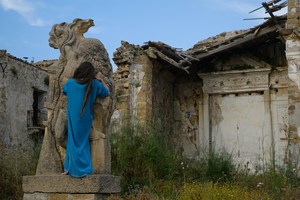
"I work with what I call operational realism meant as the interest for the functional sphere, its presentation in an aesthetic arrangement and its inter-relations. Since 2007, I have been researching plant seeds, vegetal consciousness and agency, plant analogies and plant imagery, patents applied to plants, natural and artificial reproduction of plants, regional biodiversity, economic and ecologic impact when there are restrictions with exchange of local seeds".
Image: Egle Oddo performing at Old Poggioreale. Photo Antti Ahonen
Egle Oddo (1975, Italy) received her BA in Classical Studies then continued her studies in Department of Paining, Academy of Fine Arts in Palermo and Polytechnic of Fine Arts in Valencia. She completed her MA in 2001.
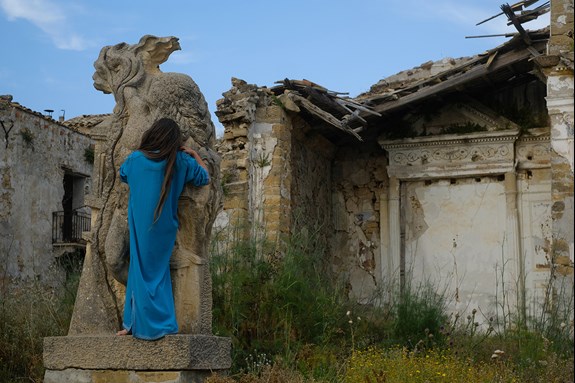
Egle Oddo performing at Old Poggioreale. Photo Antti Ahonen
Her work focuses on linear and non-linear narration as an art form. She combines photography, moving image, installation, sculpture, environmental art, and experimental live art. In her pieces industrial production morphs towards delicate handcraft, life forms appear and emerge out of sculptures and objects, film photography appropriates digital images, selected trash mixes with fashion, precious edible minerals and ancestral recipes are served as part of ritual meals.
Her work is present at International biennials, Museums and relevant institutions, as well as independent alternative spaces and events.
She was member of La Sala Naranja and she founded Namastic Art Collective. Presently she is board member of Myymälä2 gallery, and of Pixelache Trans-disciplinary Platform for Experimental Art, Research and activism. Oddo lives and works in Helsinki.
ArtDependence (AD): Do you have any thoughts on whether it is a responsibility of artists to reflect our time within the political context?
Egle Oddo (EO): I believe artists have that responsibility if they choose to embody, to impersonate, or to take on that role. Theoretically they have the freedom to shape their social role depending on their art practice, but more often fabulation is at the base of thinking about oneself in terms of a biography.
I think that wanting to have a political responsibility and impact is an individual choice that depends on personal research; I don't see it as a static option. In general it is somehow inevitable to reflect on one's own present, and not just for an artist.
Looking at your twelve questions, as an artist it would be easier for me to answer circumstantially in a non-verbal form, with a performance series for example. But here we are, communicating textually in a linear form that inevitably leaves out an aesthetic- sensorial experience of concepts and their materialization.
Actually I wish I could elicit more questions from you, and we could continue a dialogue after and beyond this interview.
AD: What is your main interest as artist? What form of self-consciousness is applicable to the art-making?
EO: I work with what I call operational realismmeant as the interest for the functional sphere, its presentation in an aesthetic arrangement and its inter-relations. Since 2007, I have been researching plant seeds, vegetal consciousness and agency, plant analogies and plant imagery, patents applied to plants, natural and artificial reproduction of plants, regional biodiversity, economic and ecologic impact when there are restrictions with exchange of local seeds. I investigate botanic, economic and political connotations that plants have in human life, but in the end I wish to create artworks that relate with plants avoiding the typical anthropic categorization dictated by functionalism. To operate this leap, I work in an aesthetic and sensorial manner with the knowledge I gather. For example I create living sculptures and installations en plain air in urban areas, fading the demarcation line between sites for cultivars, urban landscape and wilderness. I start the process by designing specific seeds collections in relation to each place and its community. I mostly gather the seeds myself mixing cultivars and wild species. I work the land by hand, and I plant the seeds with a communal ritual.
The congregation of plants initially grows under my guidance and then it is left to thrive without human interference. In the long term the spot becomes noticeable from its surrounding thanks to its biotic differentiation marked by surprising assemblages of species and new aesthetic formations. I was greatly inspired by the texts of Gilles Clément, which I red in the early 2000, and perhaps also due to this conceptual correlation part of my long-term research was included in Manifesta 12 last year, and presented in collaboration with the Department of Vegetal Biology of the University of Palermo.
I work also with other themes and I have different lines of work that probably correspond to different areas of my personality and of my curiosity.
During the act of making I do not experience any particular state of self-consciousness I could describe. Only a-posteriori I am able to analyze and establish categories to read and interpret my own work. But to me it is much more desirable if somebody else would engage with the possible significance of what I do, as my interpretation would necessarily be biased. And for the artwork to exist it needs to be experienced and perceived by the public.
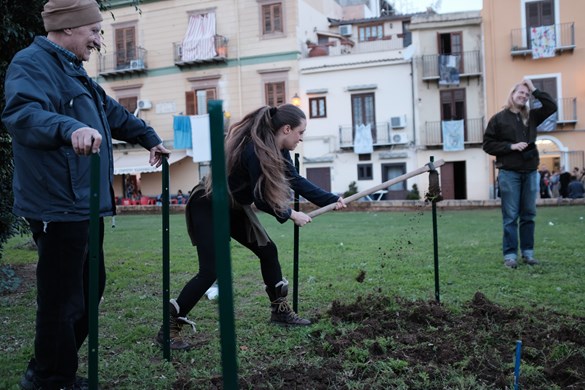
Egle Oddo installing a collection of seeds in Piazza Magione for Manifesta12. Photo Antti Ahonen.
AD: Do you feel that it’s important to convey your own beliefs and opinions within your art? Is there a philosophical element in your work?
EO: I think that inevitably your own values will be reflected into your actions, not excluded creative actions, what is more difficult is to be conscious of it. There is always an intention, a stance of the spirit before creating a work, but I don't believe that the intention and the final result are identical or even directly corresponding each other. I actually believe that after a work is published, the manifold interpretations that the work is able to elicit will represent its identity dynamically. I think that the artist cannot predict what the work will mean to the world.
Luckily an artist has all the rights to have a non-linear, problematic, incoherent, and even incomprehensible opinion. An artist doesn't need to be functional, not as scientists and politicians do.
Unless the artist chooses to embody, to impersonate, or to take on that role.
AD: What are you currently working on? Is there anything in particular that you’d like to get across through your work?
EO: I am experimenting with extremophile plantsat the moment. Extremophile plants can survive in conditions that are impossible for most plants populations. In 2015 I have started a research about the progressive desertification process starting in South of Europe, and I have gathered some data on possible factors that could cause desertification in Nordic countries, of course they are completely different factors, but there is a real unforeseen danger for it. In this study I am analyzing ecological and anthropological aspects that seem to be common to the 'extremification' of habitats from human and non-human point of view. I called this body of work The World in Common, it is in process and yet unpublished. The research and the outcomes will be implemented in collaboration with curator Basak Senova, cultural manager Johanna Fredriksson, biologist Emmy Vershuren, Professor of botany Anna Scialabba, peer-to-peer configurations expert Myles Byrne, anthropologist Pekka Tuominen, and documentarist Antti Ahonen. I like to work in group, because it deepens the quality of the research and it widens the perspective of the outcomes.
AD: What place does creativity has in education? Do you view yourself as a creator?
EO: An inventor.
Education needs creativity as a trigger for curiosity, and for the desire to discover and invent the world.
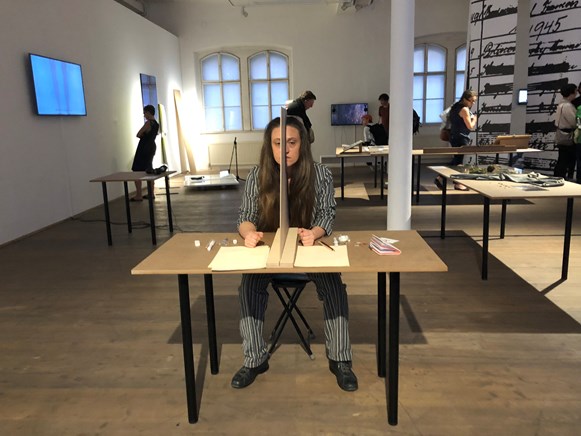
Splitter, performance installation at Kunsthalle Exnergasse Vienna. Photo Timo Tuhkanen.
AD: Do you think that by challenging conventional views, art can truly make a change in the public’s perception?
EO: What actually doesn't affect the public's perception of reality? Anything does it or could do it, including art. I don't see this judge separation between the language of art, its presence inside a given society and the rest of human activities.
This seems an interrogation that would typically imply dualist thinking, and philosophically speaking I am not convinced of its validity. What is depicted with this question is a sort of Schrödinger's cat dilemma. When one looks into the box one will only see the cat dead or alive, the way question is posed it wants to hear Yes or No. But taking into account the complexity of the phenomena and its factors, the cat is in fact simultaneously alive and dead.
Similarly art is de facto changing the public's perception, until one asks this question looking into the box and pretending to unravel the delicate entanglements of meaning, symbolism, iconography, and social interactions.
AD: How has your work developed since you began and how do you see it evolving in the future?
EO: I began in the late '80 with photography, painting, and installation; I had a very vivid interest for human body and figuration. I was taught to draw when I was six by my grandfather Paolo, who was a Professor at the Fine Arts Academy. Later the art critic Francesco Carbone discovered me when I was 14, I had painted my own room almost entirely with fresco, and he started to follow my progress and to encourage me. He wrote a text on my work and I presented it when I won the Felice Casorati prize in 1999.
During the years the range of techniques I use has become wider, and my pieces are often cross-disciplinary. I would say that I deal with my work in a more complex manner than before, also in terms of references, content and methods for communication.
AD: Is sophistication, aesthetic accomplishment in the eye of the beholder?
EO: The observer is only a participant who has temporarily chosen contemplation.
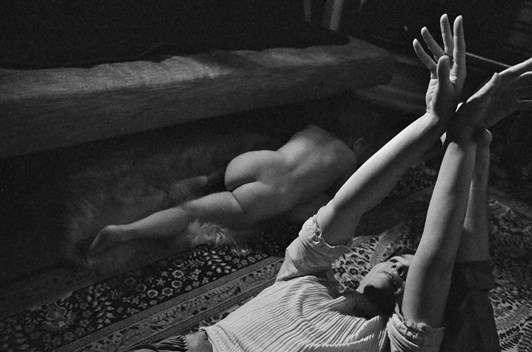
PPP - The Heart of the Screen, image from 35mm photo series, tribute to Pier Paolo Pasolini.
AD: What do you think is the social role of art? How would you like to be remembered?
EO: First of all I am very superstitious so I will definitively not engage in any post-mortem remembrance of myself. Art is a form of communication extending its range from linearity to non-linearity and beyond. Its social role is precisely to communicate in a way that simple analysis or production of knowledge cannot possibly grasp.
AD: How does art school form ideas about art? Does it shape people into being certain types of artists?
EO: Since 2008 I have taught Phenomenology of Contemporary Art, so I have both experiences as an art student and an art teacher. I think as the old proverb goes: "When the Pupil is ready the Master appears", meaning that the teacher can do all efforts to pass the knowledge, but the passage itself depends ultimately by the student. A certain art student will have the tendency to feel attracted by certain methods and contents, perhaps first replicating them, and then refining them in a personal way. Schools are a very important social and aggregative factor, a gathering force, they are important to stimulate the critical thinking and to form methods for peer review.
AD: What do you think about the art world and art market? Do you accept that art is inherently an elitist activity?
EO: I think the second is a pre-assumption and I do not agree. Art has happened and keeps happening in all types of socio-economic circumstances. Art is not inherently the prerogative of a class or a cast, but it is a form of expression of humans since Neolithic time, and to my knowledge there was not capitalism yet. It is self-evident that art is not elitist if one looks at how transversally it appears in each society, but to see that one needs to dig archives and anthropological research a bit outside of the strictly westernized mainstream radar. The capability to create a work of art and to communicate it to the world does not depend on family heraldry or from one's bank account. The view about art being elitist was popularized only in the last century, and it stands only related to a capitalist system, or only if one wants to see everything though the lens of the market.
If we talk about the art market, then I agree that the art market is elitist not art, regardless if an artist accepts it or not.
The recent news in Macro Museum of Contemporary Art in Rome, are a good example of the difference between the reality and the mainstream capitalist narrative. Director Giorgio De Finis has created a project called Macro Asilo: during 18 months of relational and basically artists-run program, the Museum is open for different types of activities and interventions, performances, seminars, workshops, open studios, exhibitions, lectio magistralis, screenings, and public talks. It has become so rich with diverse activities, varied actors, and assorted publics that its enormous success has scared the institutions managing the Museum, and they are interrupting the project that was meant to continue in 2020, giving no reason for it. The problem is that the experiment of De Finis has ineluctably proven that today a Museum could be perfectly managed by the community who lives with it, it doesn't need anymore a centralized power structure, it doesn't need to receive agency from the elite in order to be functional, to conduct its activities, and most of all to attract a big amount of visitors and different publics. De Finis has demonstrated that culture and contemporary art are an integral part of human interaction and the only barrier to put this in action is precisely elite. It's as simple as that. Of course this evidence has promptly scared the infrastructures that receive their reason-to-be from the outdated belief that they are permanently necessary. So the project has been stopped. But I am sure that the curatorial activity of De Finis will find another home.
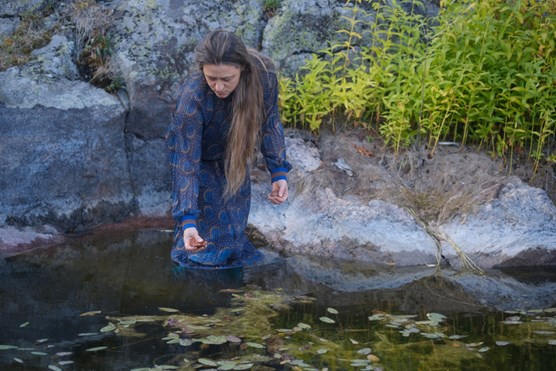
The World in Common, Egle Oddo performing during her residency at HIAP - Helsinki International Artist Programme. Photo Antti Ahonen.
AD: What’s the last great book you read? Any other thoughts/projects to share?
EO: The book: Thomas Bernhard, On the Mountain. It is not the last I red but I keep going back to it.
I leave you with a quote that Professor of International Law Martti Koskenniemi uttered after he saw one of my work with the seeds: "Your performance reminded me of aspects of the History of Property. In the Early Middle Age it was taught to people that God gave the World to all the creatures in common. But when late medieval people looked out of their window, they realised that there was very little common property left."

ArtDependence Magazine is an international magazine covering all spheres of contemporary art, as well as modern and classical art.
ArtDependence features the latest art news, highlighting interviews with today’s most influential artists, galleries, curators, collectors, fair directors and individuals at the axis of the arts.
The magazine also covers series of articles and reviews on critical art events, new publications and other foremost happenings in the art world.
If you would like to submit events or editorial content to ArtDependence Magazine, please feel free to reach the magazine via the contact page.